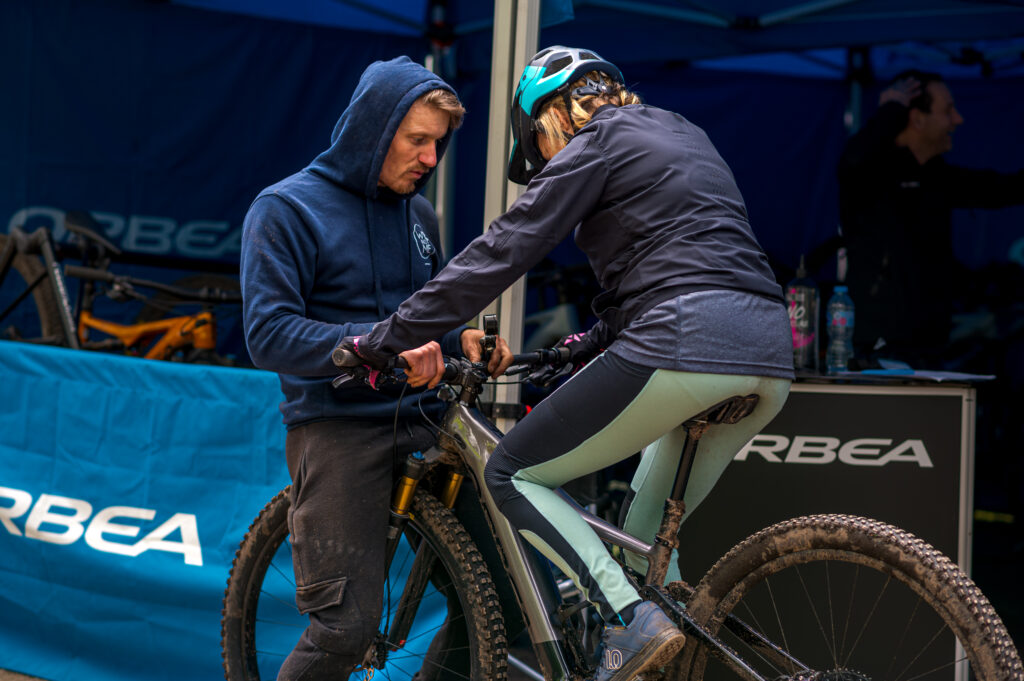Before you head out on a ride, it’s vital that you spot any potential problems – Follow these six essential checks before every ride to ensure your safety!

Wheel Axle Quick Release/Thru-Axle
It’s thankfully rare for wheels to just fall out of frames, but it pays to check your quick release levers for tightness and that they’re closed correctly. When the levers are tight, give the top of the wheel a sharp downward tap with your hand to check their safety. While you’ve got the wheels in hand, give the rims a little side to side wobble check to feel for loose hub bearings. Any looseness will mean an adjustment or hub bearing replacement is necessary.
Brakes Functioning
The ability to stop your bike’s forward progress is essential for your safety. If you manage only one of these checks, make sure it’s the brakes which get done first. Pull the levers with your normal braking force. Push the bike hard forwards: the wheels should be stopped and effectively locked.
Both brakes should operate with the same hand force, come on at the same time and return quickly and cleanly to their off position when released. Try the cable pinch bolts for tightness.
Check all plastic cable housings and the rubber brake pads for wear and UV damage. If your callipers have cam-operated side adjusters make sure they’re in the closed position, as shown above.
Tyre Pressure
Low tyre pressure won’t necessarily mean a bad or ruined ride, but if it’s too low it can lead to punctures, tyre damage, tyre wear or rim damage. Best to keep a bit more air in them than a bit less. However, too much will make for a bone-jarring ride. Follow the manufacturer’s recommended pressure range (usually embossed on the sidewall of the tyre), as a starting point and adjust from there.
There are no right and wrongs, instead, develop a feel for the right pressure for you and your setup. Try a pressure gauge for empirical figures. Failing that, get to know what suits by using the Mk1 human thumb. They’re pretty accurate.
Bolt Check
Getting your bike to point in the right direction means having the controls and levers all properly tight. More tension on stem and handlebar bolts isn’t always better, especially with carbon components. You want controls to be tight enough not to move under normal operating forces, yet not so tight, that in the event of a crash or collision, they won’t move. It’s better they move or rotate than snap. If there’s any carbon fibre involved, use a torque wrench and tighten to the exact torque specified by the manufacturer.
Likewise, ensuring that the pedal & cranks are tightened properly, you should not feel any play or movement when pulling down.
Chain Lubed
Keeping your chain properly lubed is vital to keeping your gears working smoothly, quietly and efficiently, it also helps prevent corrosion to make both the chain & cassette last longer. First, ensure that you are applying lube to a clean chain, this is to ensure you are not putting lube on top of any grit and dirt that may wear down your chain & gears. Next, apply the lube to the lower half of the chain, with approximately one drop per link, moving the chain along by rotating the pedal backwards. Once you’ve done the inside of the chain, cycle the gears backwards a few times to allow the lube to get into every chainlink. Now you’ll need to wipe off any excess lube with a cloth while back-pedalling the chain – after that you’re good to go.
Gear Check
You can often ride around malfunctioning gears, but you can remove the need by spotting the issues which cause them first. From behind the bike, check that the derailleur hanger is straight and in line with the jockey wheels. Likewise that the jockey wheels are in line with the sprockets. If they’re not it’s usually a sign that the hanger (occasionally the derailleur arm) is bent. Derailleur hangers can be straightened or replaced, a bent derailleur can be repaired though often this is as expensive as buying a new one.
Run through the indexing: shifts should be clean and crisp. The chain should not be able to be shifted beyond the upper and lower limits of the cassette.
